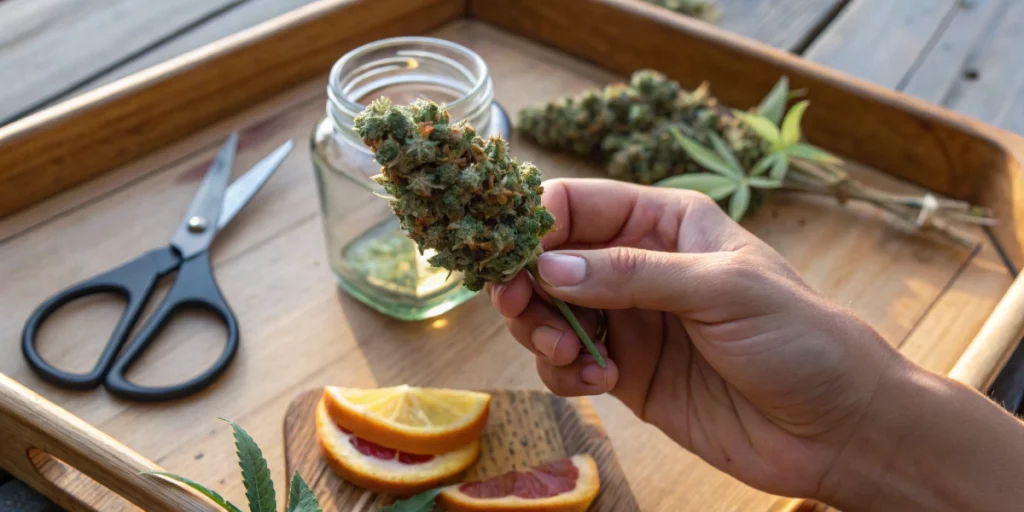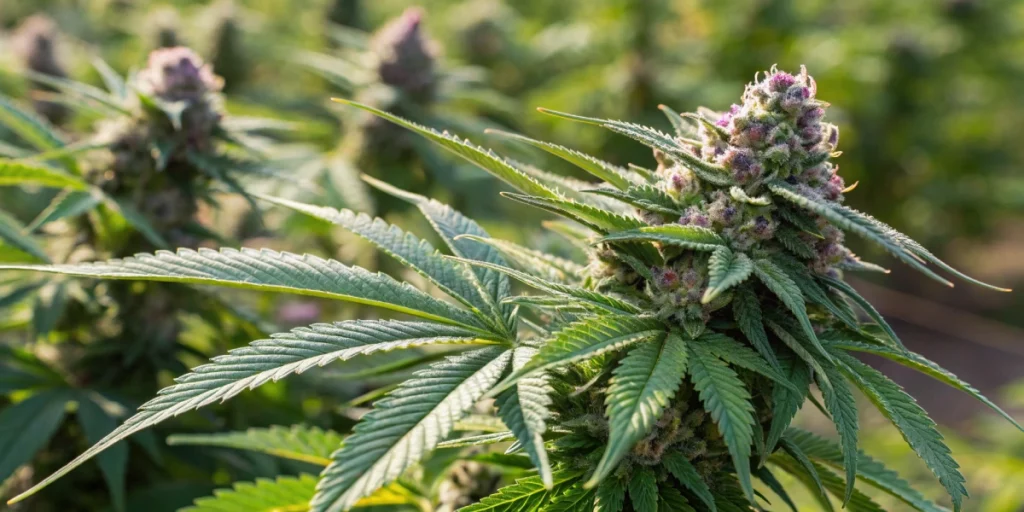What if you could grow a plant that not only smells like a candy shop but also delivers rich effects and a quick harvest? This is exactly what makes Fruit Spirit strain a favorite among growers. It combines strong genetics, bold flavors and an uncomplicated grow cycle. Stay with us to learn the exact steps to bring out its full potential and make the most of every harvest.
Fruit Spirit Strain: Exceptional Genetics and Effects
Origins and Genetics
Fruit Spirit strain is a hybrid that brings together the sweetness of Blueberry with the sharpness of White Widow. This cross was designed to create a plant that grows fast, produces dense buds and explodes with fruity flavor. It’s not just about taste, though, these parent strains also bring strength, resilience and well-balanced structure to the table. The result is a stable and vigorous hybrid that performs well in a wide range of environments and mediums.
The genetic balance of Fruit Spirit strain leans slightly toward sativa, which means you can expect medium height, strong lateral branching and steady vertical growth. Its phenotype remains consistent across different grow methods, making it ideal for beginners and seasoned cultivators looking for predictable results. Whether you’re growing in soil, coco or hydro, this strain adapts smoothly while keeping its signature fruity aroma intact.
Effects and Potency
When smoked or vaped, Fruit Spirit strain brings an immediate boost in mood and clarity. It’s often described as joyful, offering a burst of euphoria without paranoia or mental fog. THC levels usually sit between 17% and 20%, providing a well-rounded experience that works for both daytime and evening use. The onset is fast, and the transition into a calming state of mind is smooth, keeping your senses sharp but relaxed.
As the high develops, you’ll feel a mild body buzz that never becomes too heavy. This makes Fruit Spirit strain a smart option for users who want to stay functional while still enjoying relaxation. It’s especially popular among those seeking relief from stress or mental fatigue. The balanced effect profile also makes it suitable for creative tasks, conversations or winding down without knocking you out.
Environmental Requirements for Growing Fruit Spirit Strain
Setting Up the Growing Cannabis Space
Start by choosing a grow tent or area that allows for controlled airflow and lighting. Use an inline exhaust fan paired with a carbon filter to keep air clean and odor low. Intake vents should be placed low, while exhausts stay high to remove hot air rising from lights. A proper air exchange system not only reduces smells but also regulates temperature and humidity more effectively.
Line the interior walls with reflective material like Mylar or flat white paint to distribute light evenly. Use timers to control your light schedule and humidity controllers to maintain consistent levels. Keep the area clean and free from excess water or plant debris to reduce risk of pests. Consider placing a hygrometer and thermometer at canopy level to monitor exact conditions where the plants grow.
Temperature and Humidity
Maintain a stable environment between 20–26 °C during the day and around 18 °C at night. Humidity should be around 50% in vegetative stages and reduced to 40% during flowering. Proper air circulation helps avoid mold and keeps plants breathing freely. If you’re growing in a small space, use a dehumidifier to keep levels steady, especially during late flowering when buds get dense.

Indoor Cannabis Cultivation
Advantages of Growing Indoors
Indoor growers have complete control over temperature, humidity and light exposure. Fruit Spirit strain thrives in this environment, finishing its cycle in around eight to nine weeks. With a proper setup, expect higher resin production and tighter bud formation compared to outdoor grows. Indoor cultivation also allows for stealth grows and year-round harvesting, regardless of external climate.
Plants stay under one meter tall, making them suitable for closets, tents or discreet home setups. You can use training techniques like LST or ScrOG to further increase yields and manage canopy height. This strain responds well to these methods and rarely shows signs of stress. Because of its manageable size and responsive growth, indoor growers can truly fine-tune every detail of their setup.
Lighting Needs
Use full-spectrum LED lights positioned 30–40 cm above the canopy. During the vegetative phase, provide 18 hours of light and 6 of darkness. Switch to a 12/12 cycle for flowering. Ensure consistent light coverage to reach lower bud sites and promote even development. Adjust light height as plants grow to prevent stretching and encourage strong, compact colas.
Outdoor Cannabis Cultivation
Best Conditions for Outdoor Growth
Choose a sunny spot with at least 6 hours of direct light per day. Fruit Spirit strain grows well in warm, Mediterranean-style climates with low humidity. Start seeds after the last frost and use well-draining soil rich in compost or organic material. Position your plants where they’re protected from strong wind while still getting good airflow.
Stake your plants early to support branches during flowering. Water when the top 3–5 cm of soil feels dry, and apply mulch to retain moisture and reduce temperature swings. Prune lower leaves and small branches to improve airflow and light penetration. If pests are a concern, companion planting with basil or marigold may offer natural deterrents.
Advantages of Growing Fruit Spirit Strain
Fruit Spirit strain offers reliable flowering speed, with most grows ready to harvest in 8–9 weeks. This quick cycle allows for multiple harvests per season if you’re in a warm region. Its moderate nutrient needs and strong genetics make it easy to maintain. Even with basic equipment and feeding, it rewards growers with compact, frosty buds and minimal stretch.
Another standout is its aroma. Even during mid-flower, the scent is sweet and berry-like, attracting growers who value terpene-rich profiles. The final dried product keeps much of that fruity smell, making it a go-to for anyone focused on flavor and smooth smoke. In concentrates, its terpene profile carries over well, making it a favorite for extractors as well.
Problems in Cultivating Fruit Spirit Strain
Overwatering
Fruit Spirit strain is sensitive to overwatering, especially during the early vegetative phase. Roots can suffocate in saturated soil, leading to yellowing leaves and stunted growth. Let the soil dry between waterings and ensure pots have proper drainage. Adding perlite or coco to your soil mix helps improve airflow and prevent compacted root zones.
Pest Infestations
Like many sweet-smelling strains, this one can attract aphids and spider mites. Use sticky traps, neem oil and predator insects to control outbreaks. Keep the grow area clean and inspect your plants regularly, focusing on leaf undersides and branch joints. Rotating prevention methods keeps pests from adapting and building resistance over time.
Similar Strains
Sugar Bomb Punch
Sugar Bomb Punch delivers similar fruity flavors and compact structure, making it an excellent alternative to Fruit Spirit strain. It also finishes quickly and thrives in controlled environments.
Strawberry Lemonade
Strawberry Lemonade packs citrusy berry flavors and delivers a balanced effect profile. It’s easy to grow indoors or out and flowers in about the same time window.
Shiva Skunk Auto
Shiva Skunk Auto is another quick-finisher with rich, sweet aromas. It’s highly resilient to environmental changes and adapts well to training and tight grow spaces.
Week-by-Week Growth Plan for Fruit Spirit Strain
Week 1 – Germination and Seedling Stage
Place your Fruit Spirit strain seeds between moist paper towels in a warm dark spot until taproots emerge. Transfer to starter pots with light soil and keep humidity high. Use soft light for 18 hours per day to support steady seedling growth. Keep the temperature around 22 °C and check for mold or overwatering daily.
Week 2 – Early Seedling Growth
Seedlings develop true leaves and start building a small root system. Keep soil moist but not wet. Use gentle airflow and indirect light to prevent stretch. No nutrients needed yet if soil is pre-fertilized. The main goal is to help plants establish roots without stressing them too early.
Week 3 – Continued Seedling Development
Plants grow their second and third leaf pairs. You can start low-dose nutrients if using inert media. Light intensity should increase slightly and airflow maintained to avoid damping off. Plants may now be ready for early training like leaf tucking or gentle LST to begin shaping the canopy.
Week 4 – Vegetative Growth Begins
Fruit Spirit strain enters a vigorous vegetative phase. Transplant to larger pots. Use a full vegetative nutrient mix and begin light training to spread the canopy. Maintain 50–60% humidity and 24 °C. As roots expand, the plant will double in size, requiring more frequent watering and close monitoring of growth patterns.
Week 5 – Accelerated Vegetative Growth
Increase nutrient strength to full vegetative dose. Continue training for even growth. Plants should reach 30–40 cm. Watch for signs of deficiencies or pests. Water deeply, then let soil dry slightly before watering again. This week often sees rapid foliage growth, so light pruning may be necessary to maintain airflow.
Week 6 – Preparing for Flowering
Switch to a 12/12 light cycle. Introduce bloom nutrients with higher phosphorus and potassium. Reduce humidity to 45%. Bud sites start forming along branch tips and nodes. Gently defoliate any leaves blocking lower bud sites. This early shift in nutrition and lighting cues the plant to begin reproductive growth.
Week 7 – Transition to Flowering
Bud development begins and pistils appear. Remove large fan leaves blocking light. Light defoliation improves airflow. Keep environment stable and avoid dramatic changes in temperature or nutrients. Bud sites multiply quickly during this phase, and resin starts to appear as trichomes begin forming.
Week 8 – Early Flowering
Flowers thicken and trichomes start to appear. Aroma becomes noticeable. Continue bloom feeding schedule and check for pests or mold. Humidity should be stable around 40%. Buds are small but sticky and increase in size every day. Aroma starts to fill the grow space and fans should be optimized.
Week 9 – Mid-Flowering
Buds swell and trichome coverage increases. Inspect for cloudy trichomes and pistil color change. Support branches if needed. Lower nitrogen levels and keep potassium high. By now, the buds are developing their final shape, and most foliage growth slows significantly.
Week 10 – Bud Development
Resin builds up and aroma peaks. Most pistils turn orange. Begin flushing if trichomes are mostly cloudy. Maintain ideal drying conditions around harvest. This phase is all about maximizing flavor, trichome density and ripeness before final flush and harvest timing.
Week 11 – Late Flowering
Final fattening of buds. Trichomes turn from cloudy to amber. Stop nutrients and flush with pure water only. Prepare drying area and harvest tools. This week ensures a smoother smoke and better flavor by eliminating excess minerals in the plant tissue.
Week 12 – Harvesting Time
Harvest when trichomes are mostly cloudy with 10–20% amber. Hang branches upside down in a dark, cool room for 7–10 days. Trim and cure buds in glass jars for 2–3 weeks. Use humidity packs to control moisture levels during curing.
Week 13-14 – Curing the Buds
Burp jars daily during the first week, then every two days. Keep them in a dark place to develop flavor. Fruit Spirit strain preserves its fruity notes well with a good cure. The longer the cure, the smoother the smoke and stronger the scent.

FAQs about Fruit Spirit Strain
How long does Fruit Spirit strain take to flower?
It usually takes 8 to 9 weeks from the start of flowering to harvest. Timing may vary slightly depending on grow method and environment, but most indoor grows are ready after week nine.
Is Fruit Spirit strain good for beginners?
Yes, it’s easy to grow and not very sensitive to mistakes. With moderate feeding and basic training, even new growers can achieve solid yields and high-quality buds with fruity flavor.
What does Fruit Spirit strain smell like?
It smells like sweet berries with hints of sugar and citrus. As buds mature, the aroma intensifies. After drying and curing, the scent remains strong and carries over into the flavor.





